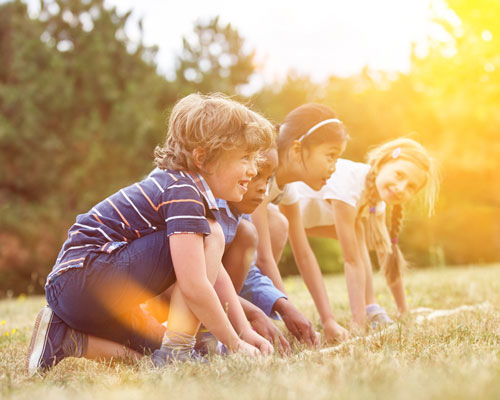I would get home from school, grab a snack, change clothes, and rush to join my friends running around the parks and open spaces of our subdivision. I climbed trees. I dug in the dirt. I collected rocks. I built forts. I dammed streams. Today, I still live in a family orientated subdivision; however, I rarely encounter any young people outside. According to the National Wildlife Federation, the average young person today spends less than 30 minutes a day outdoors. Reduced recess time, stranger danger and screen based entertainment have all conspired to keep our young people indoors and insulated from the natural world.
There are some very real and important reasons to provide young people with access to outdoor time. Increasing research shows that outside play and learning can provide these benefits:
Physical Heath
Outdoor time positively affects health. There is a gathering storm of childhood obesity and lack of physical activity in the United States. Getting young people outside gets them moving and provides access to fresh air and sunlight. Moving around burns excess energy and lowers anxiety. Sunlight stimulates the pineal gland and makes us feel happier.
Cognitive Benefits
A growing body of research shows that outdoor time can make young people smarter. Time spent in nature improves awareness, reasoning, observational skills, memory, communication, concentration, imagination and creativity. Exposure to environment-based education has been shown to increase critical-thinking skills and test performance.
Social-Emotional Learning
Being outdoors learning or playing stimulates social interaction. Young people work more collaboratively and communicate more when they are outside. Just being free to move around provides the opportunity to interact with new social groups. Outside play and learning requires different skills from the classroom, and can provide a sense of freedom and autonomy.
Spirit
The natural world is filled with beautiful sights, sounds and textures that excite our senses. The sunlight on our faces, the wind in our hair and the songs of birds all serve to reduce stress and anxiety. Once outside, young people are given a greater freedom to be louder and messier.
Planning for Time Outside
The first hurdle when planning outside time is the challenge of your location. Some of us will have a great location with trees and space for a garden. Others will only have a simple square of asphalt. Whatever space you have, there are activities that can be used to get young people up and outside. Remember: Just the act of being outdoors allows the leeway for more movement, mess and noise—which are all important for development.
Outside is a great place for STEM learning. Astronomy, botany, biology, meteorology, geology and ornithology are just a few of the STEM topics that start in the great outdoors. Just being outside inspires STEM thinking. Why is the sky blue? Why do I have a shadow? Teaching STEM outdoors naturally encourages observation, hypothesis making and critical thinking, all while providing concrete examples of the science in action.
15 Simple STEM Activities That Get Kids Outside
(and help them be happier, healthier and smarter)
- Go digging in the dirt. Use hand lenses and microscopes to examine the different kinds of dirt. Was the dirt man-made or did it come from rocks or plants?
- Keep a nature journal of things seen and discovered during outdoor time.
- Build a bird feeder and record the birds that come to visit.
- Build a bridge or a dam. Find a natural obstruction and use items from nature or craft materials such as straws and Popsicle sticks to overcome it.
- Apply STEM themes to active games you already know, such as Tag, Red Light-Green Light or Duck, Duck, Goose.
- Survey the plants at your location. Explore where plants like to grow and illustrate the different plants discovered. (Hint: weeds count.)
- Leave a scrap piece of board outside for couple of days, on some dirt. Then lift it up to discover how many species have found shelter under it.
- Buy butterfly nets and an insect guide. Work together as a group to sweep a grassy area and discover what critters might be present.
- Go to a garden center and purchase ladybugs. Study these beneficial bugs and then release them outside.
- Examine the rocks found at your location and make a local rock collection.
- Learn about different cloud types. Become cloud spotters. Put out a weather station and record the daily weather. Predict the weather for the following day.
- Do a plant survey. Count how many different plants are in several randomly selected square meters, and then multiple by the size of your area to determine the total plant population.
- Measure out volumes of water and determine the volumes of differently shaped containers by pouring the water from one to another.
- Organize a scavenger hunt. Observe and record the location of things such as footprints, birds, three-lobed leaves, a snail, et cetera.
- Teach the basics of taxonomy by having the children collect items such as leaves and rocks, and then challenge them to place their collections into groups.
Contributed by Andy the Science Wiz, NAA's STEM Specialist Andy Allan.




